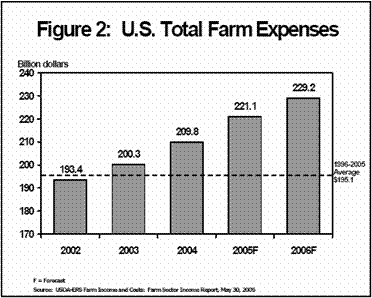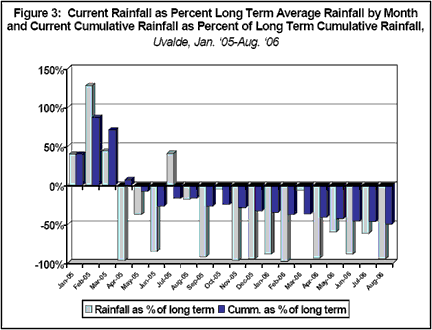Click here for the Acrobat version of this publication.
AG-ECO NEWS
Vol. 22, Issue 27, August 23, 2006
Jose G. Peña
Extension Economist-Management
U.S. Net Farm Income Down 23%, Even with Improved Markets;
Drought and High Energy Costs Will Make 2006
a Difficult Year for Agriculture
USDA’s initial, April ‘06, forecast of U.S. net farm income for 2006 at $56.2 billion is down $16.4 billion (22.6%) from $72.6 billion in net income in 2005. (See Figure 1). While livestock and grain markets have improved significantly and the outlook appears good, the continuing severe drought and high energy costs indicate that 2006 will be a difficult year for agriculture. Also, USDA’s initial estimate of total U.S. agriculture production costs, at $229.2 billion, is up 3.7 percent from last year and up 17.5 percent from a 1996-2005 average of 195.1 billion. (See Figure 2). This means increased financial risk, and while market prices are up, the estimate of farm program payments is down, meaning more risk.

 USDA will probably reduce the estimate of net farm income as the drought in a major portion of the U.S. is causing increased crop failures/reduced yields, and high energy costs are increasing production costs.
USDA will probably reduce the estimate of net farm income as the drought in a major portion of the U.S. is causing increased crop failures/reduced yields, and high energy costs are increasing production costs.Both farmers and ranchers face major crop failures this year as a result of the continuing drought. Crop agriculture is experiencing increased irrigation requirements at a critical time of record high energy costs.
Initial loss estimates for Texas indicate that agricultural producers will lose about $4.1 billion due to the drought. Dr. Carl Anderson, Professor Emeritus, recently estimated crop losses in Texas at $2.5 billion and livestock losses at $1.6 billion.
Most of the Central U.S. region and especially the southwest region of Texas is experiencing a severe drought. The southwest Texas region, which probably closely mirrors the moisture situation in over 50 percent of state, has only received about 7.2 inches of scattered rainfall in 365 days, from August 21, 2005 through August 21, 2006. This 365 day period is the driest on record. Unseasonably hot temperatures are aggravating the dry spell.
The drought really started in June ‘05 when cumulative rainfall dropped 27 percent of the long term average. Since then the rainfall situation has continued to deteriorate, dropping cumulative rainfall during the last 20 months (January ‘05-August 21, 2006) to about 50 percent of the long term average. (See Figure 3). Weathermen define a true drought as a period when 75% or less of the long term average yearly rainfall has been received.
The moisture situation is actually worse than records indicate. For example, since from an agronomic point of view, rainfall in a day should equal to or exceed one-quarter of an inch to be economically significant, if we eliminate the days with less than one-quarter of an inch, only 4.52 inches of usable rainfall have been received during 365 days. The moisture situation is rapidly approaching the multi-year drought of record in Texas of the 50’s.
Agricultural producers should prepare in-depth financial plans which cover short and long term goals and objectives and take into account the effects of a potential continuing drought over the next few years.
